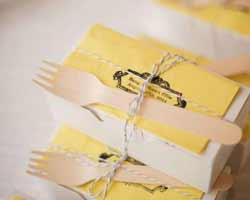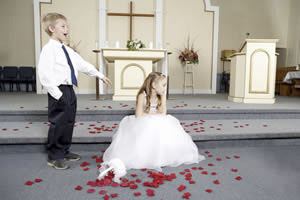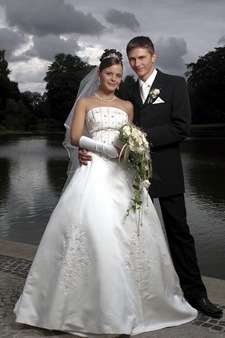
Today, wedding photography is taking unconventional swings. “Wedding portraits can be so much more than a bride and groom standing in front of a fountain,” says photographer Jeff Tisman. He started out his career doing fashion and music photography and later got into wedding photography. He does his posed shots in a more relaxed and artsy way; others are black and white candids with a rock ‘n roll edge.
He emphasizes the importance of choosing a wedding photographer that you feel comfortable with. “I’m only half of the equation,” Tisman says. “My clients have to meet me half-way; they have to want something different.”
Wedding photography ranges from the traditional to the artistic to photojournalsticto the avant-garde. The benefit of the more traditional approach is that the results will be somewhat predictable. Other options allow the photographer to work in less direct ways with the wedding party and to inject his or her own style. It’s a personal choice; envision how you want to remember your day and move forward.
NYIAD guide to choosing a wedding photographer.
Wedding photography is both an art and a science. The wedding photographer acts a portrait artist, an architectural photographer, a photojournalist, a product photographer, and a fashion photographer—all in the same day. In addition to evaluating his or her photography, assess the photographer’s professional skills and personal demeanor. Do you trust the photographer? Do you get along with him or her? Keep in mind that on the big day you’ll be working with the photographer for eight hours or more.
“Personality is important,” says New York photographer Michael Cody. If you’re envisioning a very formal, elegant reception, choose someone with classic sensibilities. On the opposite end, if you’re a couple with a raucous sense of humor, and picture the event as being a casual soiree with non-stop dance, choose a photographer with a similar disposition.
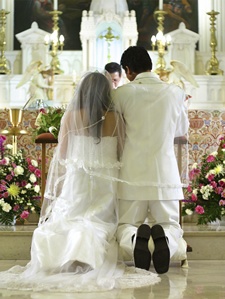
At the consultation, check out the wedding photographer’s portfolio. Do you like albums that the photographer has created? “Nowadays, clients really hire a wedding photographer for his or her style,” says wedding photographer, Monika Broz.
She recommends having the photographer you choose do your engagement photo. “That way, the couple trusts you more,” Broz notes. “They are more at ease on their wedding day and feel more comfortable doing out of the box shots.”
Recently, more and more wedding photographers incorporate photojournalism into their art. They focus on telling the story of a day. The benefits of this approach are the candid shots and portrayal of the movement of the event.
Others, such as Broz, choose to blend documentary and fine art. “I like to find the eccentric in everything,” she says. And art it is, employing everything from the surreal special effects, to focuses with shallow depth of field, to intimate candids, to poised poses with unconventional backgrounds.
What style of photography is in line with what you want? How much do you want to spend? After choosing the right wedding photographer, get to the nitty gritty and draw up a contract to eliminate later confusion.
It should include elements, such as:
- Arrival time
- Number of assistants
- Kinds of cameras to be used
- Approximate number of pictures
- Date your proofs will be ready
- Policy on ordering reprints
- Albums to be provided
- Sales tax, travel fees, and overtime fees
- Privacy policy
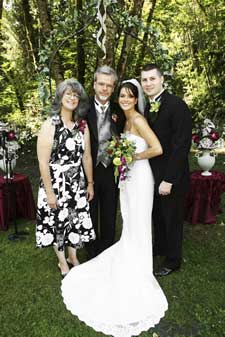
Who’s in the cast?
Before the wedding day, play the who’s who game with the photographer. Include background and original players; this will help the photographer add depth to the collection. The photographer’s familiarity with the family members of the wedding party is essential in getting complex, beautiful pictures.
It helps to orient the creative team you will be working with. Provide them with a rough timeline of the day’s events. The wedding photographer, the videographer, and the lighting artist don’t necessarily need to work together as a cohesive team, but they should all be aware of the overall theme of the wedding, and what you want.
Give the other vendors an idea of the photographer’s style. This way they won’t interrupt during posed shots, or gather everyone together for a group picture if the photographer is focusing on candid pictures behind the scenes.
Regardless of your photographer’s personal style, here are some tips for the wedding day:
- If there are certain shots that are important to you, have a must-shoot list.
- Enlist help. Get a family member or friend to act a “director” to gather people for different shoots.
- Take pre-ceremony shots.
- Get the biggest group shots done first. This will be much easier than attempting to lure people off the dance floor or away from the bar midway through the reception.
- Vary your poses.
- Wear “photo friendly” makeup that lasts and reduces shine. If you’re having black and white photos done, think about how colors will look when converted to grayscale. For instance, a darker berry lipstick may not look the best when converted to grayscale.
Wedding Photography Philosophy.
The details discussed are important, but also think about the larger picture. A photographic image escapes the restraints of worldy time, and becomes something more fluid and magical. It preserves a moment, while at the same time restructuring it. Your wedding photographs are of course important for the function of keepsake, but also allow you to have a creative relationship to the event. This is the beauty of the craft.
Want to learn more? NYIAD can teach you how to become a wedding planner today!


